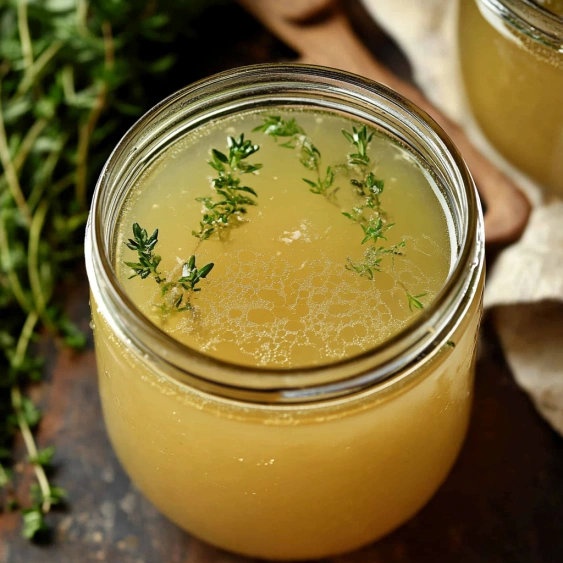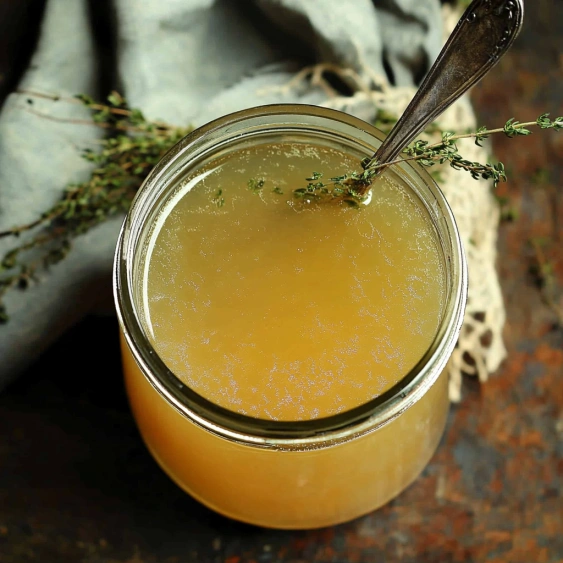 Pin it
Pin it
This homemade chicken stock transforms ordinary ingredients into liquid gold that elevates every soup, sauce, and risotto I make. After years of using store-bought versions, I discovered nothing compares to the rich flavor and soothing aroma of chicken stock made from scratch in my own kitchen.
I first made this stock during a rainy weekend when I was determined to improve my homemade soups. That first batch transformed my cooking so dramatically that I now dedicate one Sunday a month to stock making, filling my freezer with portions that make weeknight cooking effortless.
Ingredients
- Bone in chicken legs, thighs, or whole chicken: The bones provide deep flavor and collagen that creates that silky mouthfeel good stock is known for
- Yellow onion: Adds a sweet aromatic foundation without being overpowering
- Carrots: Contribute natural sweetness and beautiful golden color to your stock
- Celery bottoms: Provide an earthy flavor component that balances the sweetness of other vegetables
- Whole garlic bulb: Infuses the stock with subtle complexity without becoming bitter during long cooking
- Fresh herbs: Thyme and parsley add brightness and traditional flavor notes that dried herbs simply cannot match
- Whole peppercorns: Release flavor gradually during the long simmer creating a gentle warmth throughout
- Canola oil: Has a neutral flavor and high smoke point perfect for searing chicken without adding competing flavors
Step-by-Step Instructions
- Sear the Chicken:
- Heat your largest, heaviest pot over medium high heat until you can feel warmth radiating when you hold your hand an inch above the surface. Add canola oil and swirl to coat the bottom completely. Place chicken pieces skin side down without crowding, working in batches if necessary. Let them cook undisturbed for 4 5 minutes until the skin turns deeply golden brown. Flip each piece and repeat on the second side. This crucial step creates flavor compounds through browning that form the foundation of your stock.
- Add Aromatics and Liquid:
- Add all vegetables, herbs, peppercorns, and optional salt to the pot, arranging them around the seared chicken. Pour water over everything, making sure all ingredients are submerged. Bring the mixture to a rolling boil, which might take 8 10 minutes depending on your pot and stove.
- Long Gentle Simmer:
- Once boiling, immediately reduce heat to maintain the gentlest possible simmer just a few bubbles breaking the surface occasionally. Cover with the lid slightly ajar to allow minimal evaporation while retaining heat. Let this mixture cook undisturbed for 2 hours, occasionally checking to ensure it maintains that gentle simmer.
- Final Concentration:
- Remove the lid completely and continue simmering for another 2 hours. During this phase, some liquid will evaporate, concentrating flavors. The stock will gradually transform from watery to richly golden with a pronounced aroma filling your kitchen.
- Strain and Separate:
- Set a fine mesh strainer over another large pot or bowl. Carefully pour the entire contents through the strainer. Allow everything to drain naturally without pressing for 10 15 minutes this patience ensures a clear stock. While waiting, separate the tender chicken meat from bones and skin, reserving it for soup, sandwiches, or salads.
 Pin it
Pin it
The moment I truly fell in love with homemade stock was watching my grandmother carefully skimming the surface during simmering. She taught me that patience yields clarity both in stock making and in life. Her careful attention to removing impurities is something I still practice faithfully, and I swear I can taste her wisdom in every batch I make.
Storage Wisdom
Unlike commercial products, homemade stock has a relatively short refrigerator life of just 3 days. Store it in clean glass jars rather than plastic containers to preserve its pure flavor. Leave about an inch of headspace if you plan to freeze the stock, as it will expand as it freezes. For convenience, I freeze portions in ice cube trays, then transfer the frozen cubes to freezer bags, creating perfect small amounts for deglazing pans or adding moisture to recipes.
 Pin it
Pin it
Flavor Variations
The beauty of making your own stock lies in its adaptability. For an Asian inspired version, add a thumb sized piece of ginger, a cinnamon stick, and a few star anise pods during cooking. For deeper color and robust flavor, roast the vegetables and chicken in the oven before adding them to the pot. During fall and winter months, I often add a parsnip for subtle sweetness. Each variation becomes a signature element in different cuisines, from risottos to ramen.
Waste Reduction Approach
Making stock represents thoughtful cooking at its finest by transforming parts typically discarded into culinary gold. Save vegetable scraps, herb stems, and chicken bones in a freezer bag until you have enough to make stock. Even the strained vegetables from this recipe can be pureed with some of the stock and a bit of cream to create a quick nourishing soup, ensuring nothing goes to waste. This circular approach to cooking connects us to traditions that valued every part of our food.
Using Your Liquid Gold
Beyond soups, use homemade stock to cook grains like rice or quinoa, infusing them with flavor that elevates even simple dishes. Replace water with stock when making mashed potatoes for remarkable depth. For an impressive yet simple sauce, reduce stock by half and whisk in a tablespoon of butter for a quick pan sauce that transforms ordinary chicken breast into a restaurant worthy dish. The applications are endless, with each use demonstrating why serious home cooks consider good stock the backbone of excellent cooking.
Frequently Asked Questions
- → Can I use chicken parts other than legs and thighs?
Absolutely! While legs and thighs create rich flavor due to their higher fat content, you can use any bone-in chicken parts. Carcasses from roasted chickens work wonderfully and are economical. Wings and backs also provide excellent flavor. For the richest stock, include a mix of different parts.
- → How can I make my chicken stock clearer?
For clearer stock, avoid boiling vigorously and instead maintain a gentle simmer. Skimming impurities that rise to the surface throughout cooking also helps. For the clearest result, after straining, chill the stock completely and remove solidified fat, then reheat and strain through cheesecloth or coffee filters.
- → What's the best way to freeze chicken stock?
Cool the stock completely before freezing to prevent bacterial growth. Freeze in various portions - quart containers for soups, 1-cup containers for smaller recipes, and ice cube trays for when you just need a splash. Leave some headspace in containers as liquid expands when frozen. Properly frozen stock maintains quality for up to 6 months.
- → Can I add other vegetables or herbs to customize the flavor?
Definitely! While this base recipe creates a versatile stock, you can customize with ingredients like leeks, parsnips, fennel, mushroom stems, or different herb combinations. For Asian-inspired dishes, consider adding ginger, lemongrass, or star anise. Just avoid strongly flavored vegetables like broccoli, cabbage, or brussels sprouts which can overwhelm.
- → Why is my homemade stock gelatinous after refrigeration?
A gelatinous consistency after refrigeration is actually desirable! It indicates you've successfully extracted collagen from the chicken bones, which transforms into gelatin during cooking. This gelatin provides body, mouthfeel, and richness to your stock. When reheated, it will return to liquid form while maintaining its enhanced texture and flavor.
- → How can I make my stock more concentrated?
For a more concentrated stock, simply continue simmering uncovered longer than the recipe suggests. This allows more water to evaporate, intensifying flavors. Alternatively, after making regular stock, you can reduce it further in a separate process. More concentrated stock takes up less storage space and can be diluted when used.
